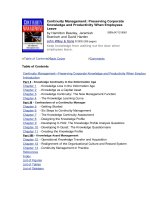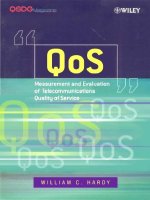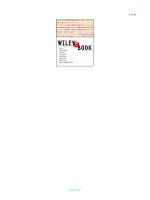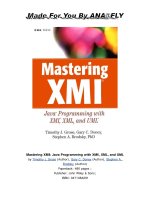John wiley sons solid support oligosaccharide synthesis and combinatorial carbohydrate libraries 2001
Bạn đang xem bản rút gọn của tài liệu. Xem và tải ngay bản đầy đủ của tài liệu tại đây (4.94 MB, 314 trang )
Solid Support Oligosaccharide Synthesis and Combinatorial Carbohydrate Libraries.
Edited by Peter H. Seeberger
Copyright © 2001 John Wiley & Sons, Inc.
ISBNs: 0-471-37828-3 (Hardback); 0-471-22044-2 (Electronic)
SOLID SUPPORT
OLIGOSACCHARIDE
SYNTHESIS AND
COMBINATORIAL
CARBOHYDRATE
LIBRARIES
SOLID SUPPORT
OLIGOSACCHARIDE
SYNTHESIS AND
COMBINATORIAL
CARBOHYDRATE
LIBRARIES
Edited by
Peter H. Seeberger
Designations used by companies to distinguish their products are often claimed as trademarks. In all
instances where John Wiley & Sons, Inc., is aware of a claim, the product names appear in initial capital
or ALL CAPITAL LETTERS. Readers, however, should contact the appropriate companies for more
complete information regarding trademarks and registration.
Copyright © 2001 by John Wiley & Sons, Inc. All rights reserved.
No part of this publication may be reproduced, stored in a retrieval system or transmitted in any form or
by any means, electronic or mechanical, including uploading, downloading, printing, decompiling,
recording or otherwise, except as permitted under Sections 107 or 108 of the 1976 United States
Copyright Act, without the prior written permission of the Publisher. Requests to the Publisher for
permission should be addressed to the Permissions Department, John Wiley & Sons, Inc., 605 Third
Avenue, New York, NY 10158-0012, (212) 850-6011, fax (212) 850-6008, E-Mail: PERMREQ @
WILEY.COM.
This publication is designed to provide accurate and authoritative information in regard to the subject
matter covered. It is sold with the understanding that the publisher is not engaged in rendering
professional services. If professional advice or other expert assistance is required, the services of a
competent professional person should be sought.
ISBN 0-471-22044-2.
This title is also available in print as ISBN 0-471-37828-3.
For more information about Wiley products, visit our web site at www.Wiley.com.
CONTENTS
Preface
ix
Contributors
xi
1 Solid-Phase Carbohydrate Synthesis: The Early Work
1
Wilm-Christian Haase and Peter H. Seeberger
1.1
1.2
1.3
1.4
Introduction 1
Solid-Phase Strategies 2
Oligosaccharide Synthesis on Soluble Polymers 7
The Period of Stagnancy (19761991) 9
2 The Glycal Assembly Method on Solid Supports: Synthesis of
Oligosaccharides and Glycoconjugates
15
Pier F. Cirillo and Samuel J. Danishefsky
2.1
2.2
2.3
2.4
Introduction 15
Why Glycal Assembly? Strategic Considerations 16
Linker Design 18
Solid Support Glycal Assembly via 1,2-Anhydrosugar
Donors 20
2.5 Solid-Phase Synthesis of the Blood Group H Determinant 23
2.6 Solid Support Glycal Assembly via Thioethyl Glycosyl
Donors 24
2.7 Solid Support Assembly via Thioethyl 2-Amidoglycosyl
Donors 27
2.8 Solid-Phase Synthesis of the Lewisb Blood Group
Determinant 28
2.9 Solid-Phase Synthesis of the Hexasaccharide Globo-H Antigen:
Progress and Limitations 30
2.10 Solid-Phase Synthesis of N-Linked Glycopeptides 32
2.11 Conclusions 37
3 The Sulfoxide Glycosylation Method and its Application to
Solid-Phase Oligosaccharide Synthesis and the Generation of
Combinatorial Libraries
41
Carol M. Taylor
3.1
Introduction 41
v
vi
CONTENTS
3.2
3.3
3.4
3.5
3.6
3.7
Synthesis of Sulfoxide Donors 44
Mechanism of the Sulfoxide Glycosylation 45
Stereoselectivity 47
Solid-Phase Oligosaccharide Synthesis 50
Libraries of Oligosaccharides 56
Outlook 63
4 The Use of O-Glycosyl Trichloroacetimidates for the
Polymer-Supported Synthesis of Oligosaccharides
67
Laurent Knerr and Richard R. Schmidt
4.1
4.2
4.4
4.5
4.6
Introduction 67
Polystyrene-Based Supports 67
Soluble Polymers as Supports 88
Oligosaccharide Syntheses on Peptides Attached to a
Solid Support 96
Conclusions and Outlook 96
5 Synthesis of Oligosaccharides on Solid Support Using
Thioglycosides and Pentenyl Glycosides
99
Valentin Wittmann
5.1
5.2
5.3
Introduction 99
Thioglycosides as Glycosyl Donors 99
Pentenyl Glycosides as Glycosyl Donors 107
6 Solid-Phase Oligosaccharide Synthesis Using Glycosyl Phosphates
117
Wilm-Christian Haase, Obadiah J. Plante, and Peter H. Seeberger
6.1
6.2
6.3
6.4
Introduction 117
Glycosyl Phosphate Donors 118
Other Phosphorous(V) Glycosyl Donors 126
Conclusion 131
7 Stereoselective >-Mannosylation on Polymer Support
135
Yukishige Ito and Hiromune Ando
7.1
7.2
7.3
p-Methoxybenzyl-Assisted Intramolecular Aglycon Delivery:
Highly Efficient β-mannosylation 139
Intramolecular Aglycon Delivery on Polymer Support:
Gatekeeper-Controlled Glycosylation 158
Conclusions 161
8 Tools for On-Bead Monitoring and Analysis in Solid-Phase
Oligosaccharide Synthesis
Wilm-Christian Haase, Peter H. Seeberger, and Susan S. Pochapsky
8.1
8.2
8.3
Introduction 165
IR Spectroscopic Methods 166
NMR Spectroscopic Methods 167
165
CONTENTS
9 Polyethyleneglycol ω-Monomethylether (MPEG)-Supported
Solution-Phase Synthesis of Oligosaccharides
vii
175
Jiri J. Krepinsky and Stephen P. Douglas
9.1
9.2
9.3
9.4
9.5
9.6
9.7
9.8
9.9
Introduction 175
Polyethyleneglycol ω-Monomethylether (MPEG) 180
Linkers 183
MPEG-Supported Syntheses Using Enzymes 190
Use of MPEG in Mechanistic Studies 192
MPEG and Combinatorial Libraries 193
Other Applications 195
Capping 196
Outlook 196
10 Two-Direction Glycosylations for the Preparation of Libraries of
Oligosaccharides
201
Geert-Jan Boons and Tong Zhu
10.1 Two-Directional Glycosylations in Solution 201
10.2 Two-Directional Glycosylations on Solid Support 204
10.3 Bidirectional Synthesis of Carbohydrate Libraries 208
11 Carbohydrate Libraries in Solution Using Thioglycosides: From
Multistep Synthesis to Programmable, One-Pot Synthesis
213
Eric E. Simanek and Chi-Huey Wong
11.1
11.2
11.3
11.4
Introduction 213
An Abbreviated History 217
Work from the Wong Laboratory 222
Future Directions 234
12 Carbohydrate Libraries by the Random Glycosylation Approach
239
Osamu Kanie and Ole Hindsgaul
12.1
12.2
12.3
12.4
12.5
12.6
12.7
12.8
Introduction 239
Strategies for Oligosaccharide Library Generation 242
Attempts to Create a Random Mixture 245
Protein Binding to Random Glycosylation Libraries 246
Compound Distribution Depends on Reaction Conditions 247
Creating Random Oligosaccharide Libraries 250
Other Approaches to Oligosaccharide Mixture Libraries 252
Conclusions 254
13 Solid-Phase Synthesis of Biologically Important Glycopeptides
Nicole Bézay and Horst Kunz
13.1 Introduction 257
13.2 Building-Block Approach 257
257
CONTENTS
viii
13.3 Direct Solid-Phase Glycosylation of Solid-Support-Bound
Peptides 273
13.4 Convergent Glycopeptide Synthesis with Polymer-Bound
Carbohydrates 275
14 Preparation and Screening of Glycopeptide Libraries
283
Phaedria M. St. Hilaire, Koen M. Halkes, and Morten Meldal
14.1
14.2
14.3
14.4
14.5
14.6
14.7
14.8
14.9
Index
Parallel Arrays versus Libraries Of Compounds 283
Carbohydrate Binding Proteins 284
The Carbohydrate Ligands 285
Supports for Solid-Phase Libraries 288
Analytical Tools for Glycopeptide Libraries 290
Glycopeptides as Oligosaccharide Mimetics 292
Parallel and Library Synthesis of Glycopeptides 294
Screening of Glycopeptide Libraries 297
Conclusions 299
305
PREFACE
Glycobiology has provided many compelling results that place oligosaccharides
and glycoconjugates in the center of a host of signal transduction processes at the
molecular and cellular levels. It was found that oligosaccharides in the form of
glycoconjugates mediate a variety of events, including inflammation,
immunological response, metastasis, and fertilization. Cell surface carbohydrates
act as biological markers of various tumors and as binding sites for other
substances, including pathogens.
A major impediment to the rapidly growing field of molecular glycobiology is the
lack of pure, structurally defined complex carbohydrates and glycoconjugates.
Although these molecules are often found only in low concentrations in nature, the
identification and isolation of complex carbohydrates from natural sources is greatly
complicated by their microheterogeneity. Detailed biophysical and biochemical
studies of carbohydrates require sufficient quantities of defined oligosaccharides. The
procurement of synthetic material presents a formidable challenge to the synthetic
chemist. While the need for chemically defined oligosaccharides has steadily
increased, the synthesis of these complex molecules remains time consuming and is
carried out by a few specialized laboratories.
Many innovative methods in carbohydrate chemistry have been developed and are
covered in several very recent (at the time of writing) books on this subject. Although
the synthesis of oligopeptides and oligonucleotides has benefited greatly from the
feasibility of conducting their assembly on polymer supports, solid support
oligosaccharide synthesis has, after some reports in the 1970s, been deemed too
difficult for a long time. More recent developments in solution-phase carbohydrate
synthesis methodology, combined with a more general appreciation of the advantages
of solid support synthesis, have led to renewed interest in this field. The advent of
combinatorial chemistry has energized investigations into methods applicable to the
generation of diverse libraries of oligosaccharides and glycoconjugates.
This book covers all of the most recent (at the time of writing) developments in the
field of solid support oligosaccharide synthesis. Included are chapters discussing
different synthetic strategies, glycosylation protocols, the use of solid supports versus
soluble polymeric supports and on-resin analytical methods. Special topics such as
the formation of β-glycosidic linkages on solid support are also discussed.
Combinatorial chemistry has provided new ways for the pharmaceutical industry
and for academic researchers to address specific problems in a time- and
resource-efficient manner. Given the involvement of specific oligosaccharide
structures in signal transduction processes, combinatorial carbohydrate libraries are
ix
x
PREFACE
expected to provide a wealth of information and to lead to a detailed understanding of
the structures involved in these processes. Because of the complexity of the task, only
few approaches have been reported. Different approaches are summarized in the last
part of this volume and keep the reader abreast of the latest developments in the field.
Finally, solid-phase glycopeptide synthesis is highlighted in two chapters
describing exciting new developments in this area.
This book covers the state-of-the-art developments in the field until the beginning
of the year 2000. At this time it becomes clear that the tremendous progress has set
the stage for the conception of an automated oligosaccharide synthesizer. The
ingenuity and hard work of many synthetic chemists will eventually lead to a situation
already familiar within the peptide and oligonucleotide arenas; defined oligosaccharides and glycoconjugates will become readily available for biochemical and
biophysical studies.
PETER H. SEEBERGER
Cambridge, Massachusetts
CONTRIBUTORS
HIROMUNE ANDO, The Institute of Physical and Chemical Research (RIKEN), 2-1
Hirosawa, Wako-shi, Saitama 351-01, Japan
NICOLE BÉZAY, Institut für Organische Chemie, Johannes Gutenberg-Universität
Mainz, Postfach 3980, 55099 Mainz, Germany
GEERT-JAN BOONS, Complex Carbohydrate Research Center, The University of
Georgia, 220 Riverbend Road, Athens, GA 30602-4712, USA
PIER F. CIRILLO, Boehringer Ingelheim Pharmaceuticals Inc., Research and
Development Center, PO Box 368, 900 Ridgebury Road, Ridgefield, CT 06877,
USA
SAMUEL J. DANISHEFSKY, Laboratory for Bioorganic Chemistry, Sloan-Kettering
Institute for Cancer Research, 1275 York Avenue, New York, NY 10021 and
Department of Chemistry, Havemeyer Hall, Columbia University, New York, NY
10027
STEPHEN P. DOUGLAS, Department of Medical Genetics and Microbiology,
University of Toronto, Medical Sciences Building, 4377, Toronto, Ontario, M5S
1A8 Canada
WILM-CHRISTIAN HAASE, Department of Chemistry, Massachusetts Institute of
Technology, 18-211, 77 Massachusetts Avenue, Cambridge, MA 02139, USA
KOEN M. HALKES, Department of Chemistry, Carlsberg Laboratory, Gamle Carlsberg
Vej 10, DK-2500 Valby, Denmark
OLE HINDSGAUL, Department of Chemistry, University of Alberta, Edmonton,
Alberta, T6G 2G2 Canada
YUKISHIGE ITO, The Institute of Physical and Chemical Research (RIKEN), 2-1
Hirosawa, Wako-shi, Saitama 351-01, Japan
OSAMU KANIE, Glycoscience Laboratory, Mitsubishi Kasei Institute of Life Sciences,
Minamiooya 11, Machida-shi, Tokyo 194-8511, Japan
LAURENT KNERR, Fachbereich Chemie, Universität Konstanz, Universitätsstrasse 10,
78434 Konstanz, Germany
JIRI J. KREPINSKY, Department of Medical Genetics and Microbiology, University of
Toronto, Medical Sciences Building, 4377, Toronto, Ontario, M5S 1A8, Canada
xi
xii
CONTRIBUTORS
HORST KUNZ, Institut für Organische Chemie, Johannes Gutenberg-Universität
Mainz, Postfach 3980, 55099 Mainz, Germany
MORTEN MELDAL, Department of Chemistry, Carlsberg Laboratory, Gamle
Carlsberg Vej 10, DK-2500, Valby, Denmark
OBADIAH J. PLANTE, Department of Chemistry, Massachusetts Institute of
Technology, 18-211, 77 Massachusetts Avenue, Cambridge, MA 02139, USA
SUSAN S. POCHAPSKY, Department of Chemistry, Brandeis University, Waltham, MA
02454, USA
RICHARD R. SCHMIDT, Fakultät für Chemie, Universität Konstanz, Universitätsstrasse
10, 78434 Konstanz, Germany
PETER H. SEEBERGER, Department of Chemistry, Massachusetts Institute of
Technology, 18-211, 77 Massachusetts Avenue, Cambridge, MA 02139, USA
ERIK E. SIMANEK, Department of Chemistry, Texas A&M University, College
Station, TX 77843, USA
PHAEDRIA M. ST. HILAIRE, Department of Chemistry, Carlsberg Laboratory, Gamle
Carlsberg Vej 10, DK-2500, Valby, Denmark
CAROL M. TAYLOR, Institute of Fundamental Sciences, Massey University, Private
Bag 11-222, Palmerston North, New Zealand
VALENTIN WITTMANN, Institut für Organische Chemie, Johann Wolfgang
Goethe-Universität, Marie-Curie-Strasse 11, D-60439 Frankfurt am Main,
Germany
CHI-HUEY WONG, The Scripps Research Institute, North Torrey Pines, La Jolla, CA
90138, USA
TONG ZHU, Complex Carbohydrate Research Center, The University of Georgia, 220
Riverbend Road, Athens, GA 30602-4712, USA
Solid Support Oligosaccharide Synthesis and Combinatorial Carbohydrate Libraries.
Edited by Peter H. Seeberger
Copyright © 2001 John Wiley & Sons, Inc.
ISBNs: 0-471-37828-3 (Hardback); 0-471-22044-2 (Electronic)
1
Solid-Phase Carbohydrate
Synthesis: The Early Work
WILM-CHRISTIAN HAASE and PETER H. SEEBERGER
Massachusetts Institute of Technology, Department of Chemistry,
Cambridge, Massachusetts
1.1 INTRODUCTION
The first steps toward solid-phase oligosaccharide synthesis date back to the early
1970s.1 Intriguing features associated with the solid-phase paradigm that prompted
researchers to explore oligosaccharide synthesis on solid support included maximized
yields by use of excess reagents, ease of purification, and synthesis speed. By 1970
solid-phase peptide synthesis,2 the concept of which had just been extended to the
synthesis of depsipeptides,3 had already been automated.4 Given the immense impact
of automated solid-phase oligopeptide5 and later oligonucleotide synthesis6 on the
development of the biochemistry and biology of these molecules, the enthusiasm for
developing related methodology for the synthesis of oligosaccharides is quite
understandable.
The level of complexity associated with the synthesis of oligosaccharides on a
polymer support is much greater than that associated with the other two classes of
repeating biooligomers. While oligopeptides and oligonucleotides consist of merely
linear chains, oligosaccharides, bearing up to four sites of potential elongation, are
often branched, requiring flexible protecting group strategies for the effective
differentiation of an array of similar functionality (hydroxyls and amines). The
formation of a new stereogenic center in every glycosylation step further complicates
oligosaccharide synthesis. Additionally, traditional acid-sensitive linker systems used
for peptide synthesis are often incompatible with the Brönsted or Lewis acidic
glycosylation conditions. Thus, a series of problems have to be considered in the
planning process: (1) selection of an overall synthetic strategy and development of
methods for attachment of the carbohydrate to the polymeric support through the
reducing or the nonreducing end, (2) choice of a solid support material, (3)
selection of a linker (support-bound protecting group) that is stable during the
synthesis but can be easily cleaved when desired, (4) a highly flexible protecting group
strategy, (5) stereospecific and high-yielding coupling reactions, and (6) on resin
methods to monitor chemical transformations.
1
2
SOLID-PHASE CARBOHYDRATE SYNTHESIS
Because of the lack of availability of several of these required methodologies, the
initial attempts described below were ultimately not continued. However, they
explored most of the fundamental issues that provide the basis for solid-phase
oligosaccharide synthesis practiced today. In this chapter we focus on pioneering
work carried out in the 1970s.
1.2 SOLID-PHASE STRATEGIES
Fréchet and Schuerch were the first to report on the synthesis of di- and trisaccharides
on a solid support in 1971.7 Glucosyl bromide 2 was attached to allyl alcohol
functionalized Merrifield resin 1 by simple alcoholysis, preparing the first
resin-bound monomer 3. The reaction was carried out in benzene or
tetrachloromethane with excess donor over 24 days in the presence of
2,6-dimethylpyridine, providing 3 in yields up to 96%, as determined by weight gain
of the resin.8 These conditions, resulting in a rather slow reaction, were chosen to
minimize side reactions often associated with activation by metal ions. The use of
p-nitrobenzoate as temporary protecting group at C6 aimed at achieving high
α-selectivity in the coupling reactions, as was established by solution studies.9 After
removal of the p-nitrobenzoyl group, the coupling was reiterated twice yielding
resin-bound trisaccharide 5 in near-quantitative stepwise yield. The yield was
determined by weight gain of the resin and on the basis of the free hydroxyls of the
latest attached sugar monomer. Cleavage from the resin was accomplished by
ozonolysis followed by reduction of the ozonide with dimethyl sulfide in varying
yields between 51% and 91% to furnish 2-hydroxyethyl glycoside 6. As no suitable
analytical method was available at the time, a high degree of α-glycosidic linkages in
the product was assumed on comparison of the optical rotation of model compounds
obtained by solution syntheses (Scheme 1.1A). Attempts to achieve β-selectivity in
the solid-phase glycosylation by changing the electronic properties of the
C6-protecting group9 were not successful.8 While long reaction times and the failure
to selectively synthesize β-linked glycosides severely limited the generality of this
approach, α-linked 1,6-oligomers were prepared reasonably well.
Zehavi and coworkers introduced the original concept of a photolabile linkage10 of
the first carbohydrate monomer to the polymeric phase (Scheme 1.1B).11 Applying
essentially the same coupling conditions as Fréchet, disaccharide 8 was obtained in
approximately 90% yield per coupling step. Unfortunately, photolytic release of the
disaccharide from the resin did not proceed as well on a preparative scale as in
previous solution-phase model studies,12 and debenzylated reducing isomaltose 9 was
obtained in only 12.5%, based on resin-bound monomer. High α-selectivity in these
glycosylation reactions was demonstrated by digestion experiments using α- and
β-glycosidases.
Anderson and coworkers introduced a thioglycosidic linkage13 to the solid support
in 1976 to afford the free reducing oligosaccharide after release from the support
(Scheme 1.2A).14 Using a set of protecting groups similar to those mentioned above,
1.2 SOLID-PHASE STRATEGIES
3
resin-bound monomer 12 was obtained either by coupling of a stoichiometric amount
of thiosugar 11 to chloromethylated polystyrene, or by glycosylation of the
corresponding thiol functionalized resin with an excess of glucosyl donor in
comparable yields (about 80%). The free C6 hydroxyl group was glycosylated with
excess glucosyl donor 13 under repeated alcoholysis conditions to furnish
support-bound disaccharide 14 in 75% yield. Refluxing disaccharide 14 in benzene in
the presence of methyl iodide and benzyl alcohol as acceptor, furnished free
disaccharide 15 as the major component in a mixture of products. Gas-liquid
chromatography (GLC) analysis of the disaccharide fractions revealed an
α/β-diastereomeric ratio of 11.519:1, confirming the findings by Schuerch and
Zehavi on similar systems.9
In addition to differently functionalized polystyrene (Merrifields resin),
controlled-pore glass, as a nonswelling inorganic polymeric support was already evaluated
for solid-phase oligosaccharide synthesis in its pioneering days. Schuerch reported the
attempted glycosylation of a zirconia-coated glass surface carrying unsaturated alcohol
acceptor sites, but only poor glycosylation yields (<20%) could be achieved.15 A second
attempt by Anderson et al. was based on porous glass beads (pore size 2500 Å)
functionalized with bromobenzyl attachment sites.14 The first thiosugar monomer 11 was
quantitatively coupled to the support and subsequently glycosylated up to the trisaccharide
employing excess donor 13 in repeated alcoholysis reactions. However, coupling yields
were low even after prolonged reaction times. HPLC analysis of the cleaved trisaccharide
19 showed essentially the same α/β ratios as for reactions carried out on polystyrene
support (Scheme 1.2B).
In addition to these selective α-(1→6) glucosylations, several β-selective
glycosylation reactions have been studied on the solid support making use of
participating ester groups. Gagnaire and coworkers described two approaches to
solid-phase oligosaccharide synthesis linking the first carbohydrate monomer to the
polymeric support via an ester bond. Glucosamine acceptor 21 was immobilized by
esterification with acid chloride functionalized popcorn polystyrene at the
C6-hydroxyl. Benzoylation of the remaining free C4-hydroxyl and selective removal
of the benzoyl propionate protecting group furnished acceptor 22. Repeated
glycosylation with excess glucosamine chloride donor 23 employing Helferich
conditions furnished β-linked disaccharide 24 in 85% yield.17 This was the first time
that a sterically more hindered secondary acceptor was glycosylated on a polymer
matrix. Cleavage with sodium methoxide in methanol/dioxane and subsequent
reacetylation rendered free disaccharide 25 in 51%, yield based on polymer-bound
monomer 22 (Scheme 1.3). A β-(1→6)-linked glucosamine dimer had previously
been prepared on a popcorn polystyrene by the same group in a similar fashion.18 A
major drawback of this approach on popcorn polystyrene was considerable loss of
material at several stages during the syntheses due to partial solubilization of the
matrix.
Gentiotetraose, an all β-(1→6)-linked tetramer of glucose was selectively prepared
by Gagnaire and coworkers (Scheme 1.4).19 6-O-Trichloroacetylated glucosyl
bromide 27 was attached to succinoylated 2% crosslinked polystyrene. After selective
4
Scheme 1.1 Early solid-phase approaches to α-(1→6)-linked oligosaccharides.
1.2 SOLID-PHASE STRATEGIES
OAc
OH
A
O
BnO
BnO
11
Cl
5
OH
SH
BnO
BnO
BnO
benzene, 5d, 71%
10
O
BnO
BnO
13
O
BnO
Br
S
BnO
(3x) benzene, 2,6-lutidine,
65 °C, 3d, 75%
12
OAc
O
BnO
BnO
OAc
BnO
O
MeI, PhCH2OH,
benzene, refl. 4-5d
O
BnO
BnO
BnO
BnO
S
BnO
O
α/β =
BnO
11.5-19: 1
O
BnO
BnO
14
O
OBn
BnO
15
OAc
OH
B
O
BnO
BnO
Br
11
SH
K2CO3, H2O, quant.
16
OH
BnO
CPG
S
BnO
reiterated coupling/
deprotection
OAc
OAc
O
BnO
BnO
BnO
O
MeI, H2O
O
BnO
BnO
18
O
S
BnO
O
O
α/β =
24 : 1
BnO
O
BnO
BnO
CPG
α/β =
19 : 1
BnO
O
BnO
BnO
BnO
O
BnO
BnO
Br
CPG
17
BnO
BnO
BnO
13
O
BnO
BnO
O
BnO
BnO
O
BnO
OH
19
Scheme 1.2 Solid-phase oligosaccharide synthesis employing thioglycosidic linkages to
different solid supports.
OH
O
HO
O
Ph
O
21
OBn
O
1) benzene, pyridine, 7d
O
Cl
2) PhCOCl, pyridine
3) hydrazinium acetate,
pyridine, AcOH, 50 °C
20
OAc
O
AcHN
O
BzO
HO
O
AcHN
OBn
O
AcO
AcO
23 AcHN Cl
(2x) Hg(CN)2, benzene
85%
22
O
OAc
O BzO
AcO
O
AcO
AcHN
24
O
O
AcHN
OBn
1) NaOMe, MeOH, dioxane, 3h
2) Ac2O, pyridine
OAc
O BzO
AcO
O
AcO
AcHN
25
OAc
O
AcHN
OBn
51% based on 22
Scheme 1.3 Solid-phase synthesis of β-(1→3)-linked glucosamine dimers employing ester
linkages to the support.
6
Scheme 1.4 Solid-phase synthesis of β-(1→ 6)-linked gentiotetraose employing ester groups for permanent protection, for temporary protection, and
as linkage to the support.
1.3 OLIGOSACCHARIDE SYNTHESIS ON SOLUBLE POLYMERS
OMe
OH
B OH
34
HO
OAc
OMe
O
OH
OH
35
HO
O
AcO
Br
Hg(CN)2, low yield
36
O
O
AcO
O
OMe
OAc
AcO
AcO
AcO
AcO
31
O
B
-H2O
7
O
O
O
B
O
37
Scheme 1.5 Disaccharide synthesis on a solid support using a cyclic boronic acid ester linker.
removal of the trichloroacetyl group with ammonia in dioxane subsequent
glycosylation with disaccharide donor 29, deprotection and glycosylation with
glucosyl bromide 31 employing Helferich conditions afforded resin-bound
gentiotetraose 32. Cleavage from the support with hydrazinium acetate20 furnished the
crude tetramer 33 in almost 70% yield containing traces of di- and trisaccharides.
Changing the 2-O-acetyl group in 31 to a nonparticipating benzyl group resulted
in preferential α-glycosylation yielding 76% of disaccharide (α/β ratio 4.4:1).21 The
same support and donor were employed in the diastereospecific synthesis of
β-(1→3)-linked glucose dimer laminarabiose in good yield on 2% crosslinked
polystyrene.22 It should be noted that the stereochemical outcome of these solid-phase
syntheses was virtually identical to that in solution phase. An interesting feature of
these syntheses is the exclusive use of ester groups for both permanent and temporary
protection of hydroxyl groups and attachment to the support. The esters were
differentiated by their lability to treatment with base.
Fréchet proposed a resin-bound cyclic boronic acid ester as an unconventional
mode of attaching the first sugar monomer to the solid phase (Scheme 1.5).23 This
linkage was very selectively formed with cis-1,2 and cis-1,3-diols under mild
azeotropic conditions, leaving one hydroxyl for further chain elongation. Simple
hydrolysis of the cyclic esters afforded the free sugars. Unfortunately, couplings using
monosaccharide 31 as glycosyl acceptor proceeded sluggishly and in poor yields,1b
thus rendering this approach unattractive.
1.3 OLIGOSACCHARIDE SYNTHESIS ON SOLUBLE POLYMERS
All the described solid-phase glycosylation protocols required long reaction times to
proceed in reasonable yields because of the slower reaction kinetics on support than
in solution. Furthermore, since no analytical means were available to monitor the
progress of the reaction on the bead, development of optimal reaction conditions was
difficult. The approach described by Guthrie and coworkers in the early 1970s for
8
Scheme 1.6 The first approaches to oligosaccharide synthesis employing soluble polymer supports.
1.4 THE PERIOD OF STAGNANCY (19761991)
9
polymer-supported oligosaccharide synthesis was unique in many respects. The
polymer support was created by copolymerization of styrene with a sugar monomer
suitably functionalized with a polymerizable O-protecting group.24 This linear
polymer allowed for glycosylation reactions in homogeneous solution, thus avoiding
some of the principal shortcomings of any solid-phase approach; on the other hand,
the support could be readily precipitated for purification to take advantage of the
solid-phase paradigm. This was the only approach utilizing a glycosyl donor that was
generated on the support and was reacted with excess acceptor in solution.
Carbohydrate monomers 38 and 39 were copolymerized with styrene to yield soluble
polystyrene polymers 40 and 41, containing approximately 0.15 and 0.06 mol% of
sugar monomer, respectively. Disaccharide formation was effected via glycosyl
bromide 43 and orthoester 47 following the Kochetkov orthoester glycosylation
method (Scheme 1.6).25 Treatment of the resin with potassium acetate in refluxing
DMF (dimethylformamide) yielded gentiobiose octaacetate 51 in 42% yield, based on
the support-bound monomer 41.26 When a benzoyl linkage to the support 40 was used
instead of the arylsulfonyl linkage present in 41, cleavage by methanolysis furnished
23% of free disaccharide, based on available support-bound disaccharide 48.
This approach had several drawbacks. Most side reactions in glycosylation
reactions occur within the glycosyl donor moiety, thus terminating the growth of the
corresponding chain under this donor-bound paradigm. Moreover, repeated
glycosylations could not be used to improve coupling yields. In addition, the strongly
acidic conditions used for glycosyl bromide formation could affect acid-labile
glycosidic bonds in the oligosaccharide chain. Another disadvantage of the
soluble-polymer-supported synthesis was a substantial loss of material during the
precipitation and filtration steps following each reaction on the support.
1.4 THE PERIOD OF STAGNANCY (19761991)
The pioneering work in solid-phase oligosaccharide chemistry provided the
foundation for the rapid progress that several groups have made in the area as
described in the following chapters. These early approaches explored some of the
important fundamental issues, including different strategies (donor- vs.
acceptor-bound synthesis), various solid supports (soluble and insoluble), and linker
systems. Unfortunately, at that time this approach [was] not competitive with the
more classical solution chemistry methods, due mainly to the lack of suitable
glycosidation reactions (Fréchet),1b that would meet the demands and conditions of
solid-phase synthesis. The absence of suitable on-bead analytical tools for effective
reaction monitoring made reaction development particularly difficult. Soluble
polymers circumvented in theory some problems associated with solid supported
synthesis such as reaction kinetics and reaction monitoring. The considerable loss of
material during the workup steps also compromised the advantages of the solid-phase
paradigm, since it was less effective and more laborious than syntheses on solid
support. Eventually, the field came to a complete standstill for a 20-year period, and
with only one exception mentioned below, no further progress was reported. Major
10
SOLID-PHASE CARBOHYDRATE SYNTHESIS
advances in solution-phase oligosaccharide synthesis with regard to donor reactivity,
glycosylation selectivity, protecting group diversity, and analytical techniques were
necessary before solid-phase oligosaccharide synthesis (SOS) set the stage for the
developments described in the following chapters.
During the 1980s and early 1990s some solid-phase27 and soluble-polymersupported28 syntheses of bacterial capsular oligosaccharides were reported by
chemical formation of phosphodiester bonds. Van Boom et al. reported the only
notable advance based on chemical glycosylations on solid support, expanding the
initial attempts to the solid-phase synthesis of a large antigenic oligosaccharide that
exhibited properties of a synthetic vaccine (Scheme 1.7).29 Linear β-(1→5)-linked
galactofuranosyl homopolymers of varying length, found to be immunologically
active in Aspergillus and Penicillium species,30 were chosen as targets for a repetitive
oligosaccharide synthesis on Merrifield resin. These synthetic structures were the
basis for studies correlating oligosaccharide length and immunogenicity. Merrifields
resin was functionalized with L-homoserine, resulting in a 0.5 mmol/g loading of
acceptor resin 52. Coupling with a twofold excess of galactofuranosyl chloride 53
employing Helferich conditions furnished resin-bound monosaccharide 54
stereoselectively in 90% yield as determined after cleavage from the resin. In order to
facilitate the purification of the final products, acetylation of any free hydroxyl groups
was chosen as a capping step after each glycosylation reaction. Chain elongation was
achieved by selective removal of the C5-levulinoyl protecting group in resin-bound
monomer 54 with hydrazine, pyridine, and acetic acid and subsequent β-stereospecific
glycosylation with donor 53. The deprotection, glycosylation, and capping steps were
reiterated up to the heptamer stage. Base hydrolysis released heptamer 56 in 23%
overall yield, corresponding to 89% average yield over 13 coupling and deprotection
steps. Complete deprotection afforded the oligomers up to the heptamer in
bioconjugatable form. These semisynthetic constructs were used for biological tests
in rabbits demonstrating an increase of immunogenicity with increasing
oligosaccharide chain length.
While chemical polymer-supported oligosaccharide synthesis with the
abovementioned exception came to a halt during the 1980s, interest in enzymatic
methods for oligosaccharide and glycopeptide31 synthesis on both insoluble32 and
soluble33 polymeric supports continued since the first disclosure by Zehavi in 1983.
The intriguing features of this approach include α/β-specificity and regioselectivity,
which reduces the need for elaborate protecting group manipulations in many cases.
These methods have been reviewed elsewhere34 and exceed the scope of this chapter.
High selectivity and substrate specificity of glycosyl transferases make them
valuable catalysts for special linkages in polymer-supported synthesis. There is,
however, still a rather limited set of enzymes available to date, and the need to
synthesize a variety of natural and non-natural oligosaccharides prevails. Particularly
with regard to combinatorial approaches, chemical solid-phase oligosaccharide
synthesis promises to meet the demands most effectively.
With the development of novel, powerful, and selective glycosylating agents,35
exemplified by the introduction of glycosyl trichloroacetimidates36 to
29
Scheme 1.7 Solid-phase synthesis of an immunogenic heptasaccharide by van Boom et al.
11
12
SOLID-PHASE CARBOHYDRATE SYNTHESIS
polymer-supported oligosaccharide synthesis by Krepinsky in 1991,37 interest in
chemical solid-phase oligosacharide synthesis was revived. The following chapters
give an overview of the achievements in the field, based on significant advances in
glycosylation methodology, polymer supports, linker systems, on bead analytical
tools, and protecting group development. Today, solid-phase oligosaccharide
synthesis is competitive not only with classical solution-phase methods but also with
many of the major problems solved, as automation has come within reach. These
achievements promise significant impact on the glycosciences.
REFERENCES
1. (a) Malik, A., Bauer, H., Tschakert, J., and Voelter, W., Chemiker-Z. 114, 371375
(1990); for a more comprehensive review covering the initial studies on
oligosacchararide synthesis on polymeric supports, see (b) Fréchet, J. M., in
Polymer-Supported Reactions in Organic Synthesis, P. Hodge and D. C. Sherrington
(Eds.), Wiley, New York, 1980, pp. 407434.
2. Merrifield, R. B., J. Am. Chem. Soc. 85, 21492150 (1963); Merrifield, R. B., Angew.
Chem. Int. Ed. 24, 799810 (1985).
3. Gisin, B. H., Merrifield, R. B., and Tosteson, D. C., J. Am. Chem. Soc. 91, 26912695
(1969).
4. Merrifield, R. B., Stewart, J. M., and Jernberg, N., Anal. Chem. 38, 19051906 (1966).
5. Atherton, E., and Sheppard, R. C., Solid Phase Peptide Synthesis: A Practical Approach;
Oxford Univ. Press, Oxford, 1989.
6. Caruthers, M. H., Science 230, 281285 (1985).
7. Fréchet, J. M. J., and Schuerch, C., J. Am. Chem. Soc. 93, 492496 (1971).
8. Fréchet, J. M. J., and Schuerch, C., Carbohyd. Res. 22, 339412 (1972).
9. Fréchet, J. M. J., and Schuerch, C., J. Am. Chem. Soc. 94, 604609 (1972).
10. Pillai, V. N. R., Synthesis 126 (1980).
11. Zehavi, U., and Patchornik, A., J. Am. Chem. Soc. 95, 56735677 (1973).
12. Zehavi, U., Amit, B., and Patchornik, A., J. Org. Chem. 37, 22812285 (1972).
13. Pfäffli, P. J., Hixson, S. H., and Anderson, L., Carbohydr. Res. 23, 195206 (1972).
14. Chiu, S. H. L., and Anderson, L., Carbohydr. Res. 50, 277238 (1976).
15. Eby, R., and Schuerch, C., Carbohydr. Res. 39, 151155 (1975).
16. Holick, S. A., Ph.D. thesis, Univ. Wisconsin, Ann Arbor, MI, 1974.
17. Excoffier, G., Gagnaire, D., Utille, J.-P., and Vignon, M., Tetrahedron 31, 549553
(1975).
18. Excoffier, G., Gagnaire, D., Utille, J.-P., and Vignon, M., Tetrahedron Lett. 50,
50655068 (1972).
19. Excoffier, G., Gagnaire, D., and Vignon, M. R., Carbohydr. Res. 46, 201213 (1976).
20. Excoffier, G., Gagnaire, D., and Utille, J.-P., Carbohydr. Res. 39, 368373 (1975).
21. Excoffier, G., Gagnaire, D., and Vignon, M. R., Carbohydr. Res. 46, 215226 (1976).
22. Excoffier, G., Gagnaire, D., and Utille, J.-P., Carbohydr. Res., 51, 280286 (1976).
REFERENCES
13
23. Fréchet, J. M. J., Nuyens, L. J., and Seymour, E., J. Am. Chem. Soc. 101, 432436
(1979).
24. Guhtrie, R. D., Jenkins, A. D., and Stehlícek, J., J. Chem. Soc. (C), 26902696 (1971).
25. Bochkov, A. F., Snyatkova, V. I., and Kochetkov, N. K., Izvest. Akad. Nauk SSSR, Ser
Khim. 26842691 (1967).
26. Guthrie, R. D., Jenkins, A. D., and Roberts, G. A. F., J. Chem. Soc., Perkin Trans. 1,
24142417 (1973).
27. (a) Westerduin, P., Veeneman, G. H., Pennings, Y., van der Marel, G. A., and van Boom,
J. H., Tetrahedron Lett. 28, 15571560 (1987); (b) Elie, C. J. J., Muntendam, H. J., van
den Elst, H., van der Marel, G. A., Hoogerhout, P., and van Boom, J. H., Rec. Trav. Chim.
Pays-Bas 108, 219223 (1989); (c) Venneman, G. H., Brugghe, H. F., van den Elst, H.,
and van Boom, J. H., Carbohydr. Res. 195, C1C4 (1990); (d) Nilsson, S., Bengtsson,
M., and Norberg, T., J. Carbohydr. Chem. 11, 265285 (1992).
28. Kandil, A. A., Chan, N., Chong, P., and Klein, M., Synlett 555557 (1992).
29. Veeneman, G. H., Notermans, S., Liskamp, R. M. J., van der Marel, G. A., and van
Boom, J. H., Tetrahedron Lett. 28, 66956698 (1987).
30. (a) Bennet, J. E., Bhattacharjee, A. K., and Claudemans, C. P. J., Mol. Immun. 23,
251254 (1985); (b) Notermans, S., Wieten, G., Engel, H. W. B., Rombouts, F. M.,
Hoogerhout, P., and van Boom, J. H., J. Appl. Bact. 62, 157166 (1987).
31. Hollósi, M., Kollát, E., Laczkó, I., Medzihradszky, K. F., Thurin, J., and Otvös, L.,
Tetrahedron Lett. 32, 15311534 (1991).
32. (a) Zehavi, U., Sadeh, S., and Herchman, M., Carbohydr. Res. 124, 2334 (1983); (b)
Zehavi, U., and Herchman, M., Carbohydr. Res. 151, 371378 (1986).
33. (a) Zehavi, U., and Herchman, M., Carbohydr. Res. 128, 160164 (1984); (b) Zehavi,
U., and Herchman, M., Carbohydr. Res. 133, 339342 (1984).
34. (a) Zehavi, U., React. Funct. Polym. 41, 5968 (1999); (b) Krepinsky, J. J., Douglas, S.
P., and Whitfield, D. M., Methods Enzymol. 242, 280293 (1994).
35. Toshima, K., and Tatsuta, K., Chem. Rev. 93, 15031531 (1993).
36. Schmidt, R. R., and Kinzy, W., Adv. Carbohydr. Chem. Biochem. 50, 21123 (1994).
37. Douglas, S. P., Whitfield, D. M., and Krepinsky, J. J., J. Am. Chem. Soc. 113, 50955097
(1991).
Solid Support Oligosaccharide Synthesis and Combinatorial Carbohydrate Libraries.
Edited by Peter H. Seeberger
Copyright © 2001 John Wiley & Sons, Inc.
ISBNs: 0-471-37828-3 (Hardback); 0-471-22044-2 (Electronic)
2
The Glycal Assembly Method on
Solid Supports: Synthesis of
Oligosaccharides and
Glycoconjugates
PIER F. CIRILLO
Boehringer Ingelheim Pharmaceuticals, Inc. Research and Development Center,
Ridgefield, Connecticut
SAMUEL J. DANISHEFSKY
Laboratory for Bioorganic Chemistry, Sloan-Kettering Institute for Cancer
Research, and Department of Chemistry, Columbia University, New York, New York
2.1 INTRODUCTION
The three major classes of biopolymers found in eukaryotic systems are nucleic acids,
proteins, and polysaccharides. The latter class is the most complex with respect to
structural and stereochemical diversity. Polysaccharides indeed possess a massive
information content. Furthermore, polysaccharides are commonly found in nature
covalently attached (conjugated) to other biomolecules such as proteins, isoprenoids,
fatty acids, and lipids.1
Polysaccharides are involved in a number of significant biological functions,
beyond merely acting as structural elements and serving as sources of energy.2 For
example, they play key roles in such processes as pathogen binding, inflammation,
metastasis, and fertilization.3 To study such processes, there has been an increasing
need to gain access to usable quantities of these materials in pure form.
Oligosaccharides and glycoconjugates in living cells often exist as closely related
mixtures. Their isolation from natural sources in homogeneous form is therefore very
difficult, involving tedious purification and difficult characterization. This sequence
of steps tends to result in low yields. This difficult situation presents chemical
synthesis with a major opportunity to positively affect progress in the biochemical
understanding of the processes described above.4
The application of solid-phase synthesis and automation has revolutionized much
of the chemical and biochemical research related to peptides and nucleic acids.5 Thus,
it is likely that successful methods to synthesize oligosaccharides and glycoconjugates
15









